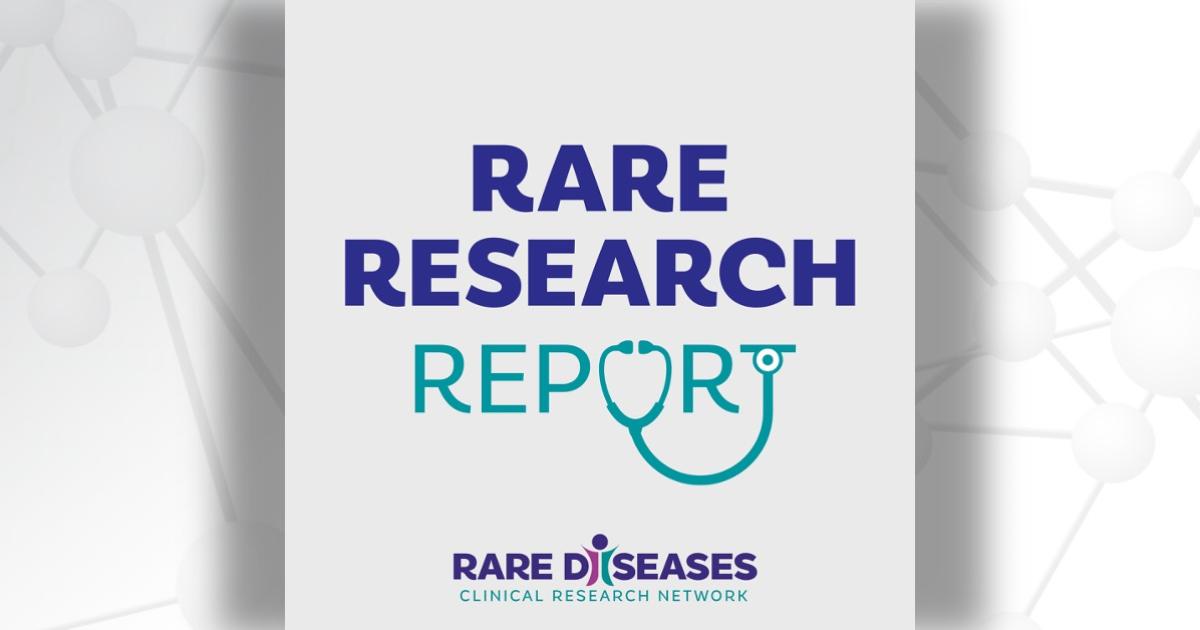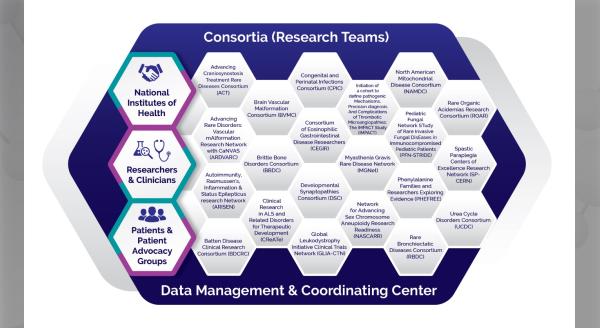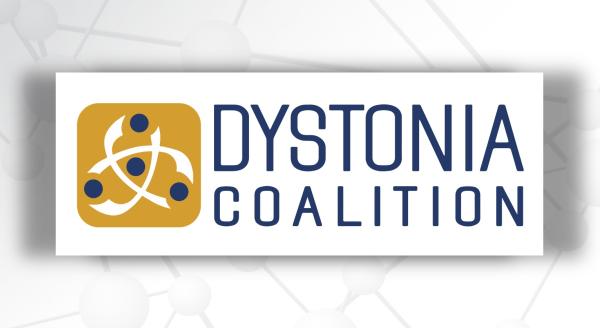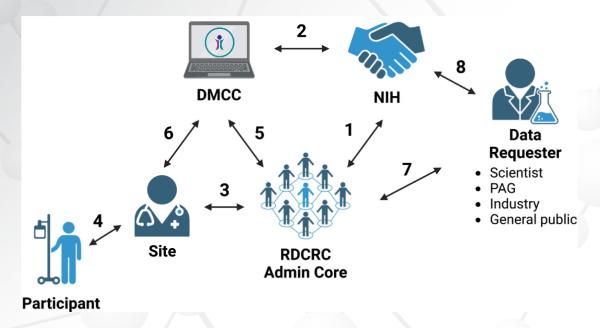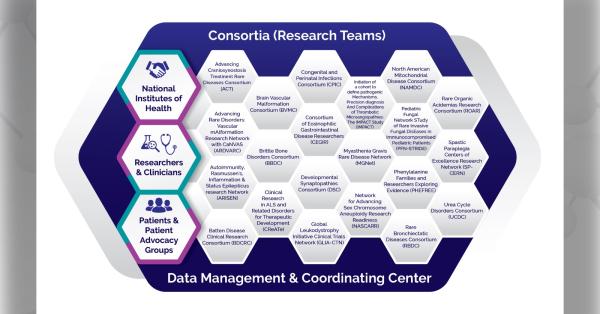Each month, we share summaries of recent Rare Diseases Clinical Research Network (RDCRN) grant-funded publications. Catch up on the latest RDCRN research below.
Jump to:
- Clinical Research in ALS and Related Disorders for Therapeutic Development (CReATe) Consortium
- Consortium of Eosinophilic Gastrointestinal Disease Researchers (CEGIR)
- Nephrotic Syndrome Study Network (NEPTUNE)
- Primary Immune Deficiency Treatment Consortium (PIDTC)
Listen to these summaries on the Rare Research Report podcast.
Clinical Research in ALS and Related Disorders for Therapeutic Development (CReATe) Consortium
Investigating Neurofilament Light Chain as a Biomarker for Amyotrophic Lateral Sclerosis
Interest in amyotrophic lateral sclerosis (ALS) biomarkers has grown exponentially over the course of the last 25 years, with great hope that they might serve as tools to facilitate the development of meaningful therapies for this otherwise progressive and fatal disease. Effective use of biomarkers, however, requires an understanding of what it means for them to be “fit-for-purpose,” as well as an appreciation of the nuances of the clinical contexts in which they will be applied.
Neurofilament light chain (NfL) has emerged as a leading candidate with enormous potential to aid ALS therapy development. However, Nfl is also profoundly misunderstood. Within the conceptual framework of the BEST (Biomarkers, EndpointS, and other Tools) Resource developed by the National Institutes of Health and the Food & Drug Administration in the United States, authors consider the evidence supporting the use of NfL for a variety of purposes in different clinical contexts.
Authors conclude that NfL may serve as a susceptibility/risk biomarker in populations at elevated risk for ALS, and that NfL has value as a prognostic biomarker when measured early in the course of established disease. Authors also conclude that NfL may serve as a pharmacodynamic biomarker, as a reduction in NfL in response to an experimental therapeutic might aid go/no-go decisions in phase 2 clinical trials. A reduction in NfL may also be a reasonably likely surrogate endpoint for experimental therapeutics administered early in the course of disease.
Benatar M, Wuu J, Turner MR. Neurofilament light chain in drug development for amyotrophic lateral sclerosis: a critical appraisal. Brain. 2022 Oct 31:awac394. doi: 10.1093/brain/awac394. Epub ahead of print. PMID: 36310538.
Consortium of Eosinophilic Gastrointestinal Disease Researchers (CEGIR)
Survey Reveals Providers’ Perceptions of Dietary Therapy for Eosinophilic Esophagitis
Eosinophilic esophagitis (EoE) is a disorder in which eosinophils (white blood cells of the immune system) build up in the esophagus (the tube that carries food from the mouth to the stomach), causing tissue damage. This immune response can occur as a reaction to certain foods. Although effective dietary treatments are often available, physicians tend to prefer medications.
In this study, researchers assessed providers’ perceptions of EoE dietary therapy, including effectiveness, practice patterns, and barriers. The team collected this data through a web-based survey of providers.
Results show that providers view diet as the least effective treatment for EoE. Barriers to treatment include the belief that patients are disinterested and unlikely to adhere. In addition, providers indicated that with less access to dietitians, nonacademic providers often manage diets without dietitian guidance. As patients are often highly accepting of diets and multiple treatment options for EoE, authors state that clinicians need evidence-based knowledge on EoE diets, access to dietitians, and awareness of patient preferences.
Chang JW, Kliewer K, Katzka DA, Peterson KA, Gonsalves N, Gupta SK, Furuta GT, Dellon ES. Provider Beliefs, Practices, and Perceived Barriers to Dietary Elimination Therapy in Eosinophilic Esophagitis. Am J Gastroenterol. 2022 Dec 1;117(12):2071-2074. doi: 10.14309/ajg.0000000000001988. Epub 2022 Sep 1. PMID: 36066475; PMCID: PMC9722505.
Nephrotic Syndrome Study Network (NEPTUNE)
Glomerular diseases are a group of conditions that affect kidney function by attacking the glomeruli, which are kidney structures responsible for filtering the blood and removing waste in urine. Diabetic kidney disease (DKD) and Alport syndrome are two types of glomerular diseases. Stimulator of IFN genes (STING)—a signaling molecule—is a crucial regulator of the cyclic GMP-AMP synthase (cGAS)-STING pathway. Under conditions of obesity, kidney fibrosis, and acute kidney injury, this signaling pathway regulates inflammation and energy homeostasis. However, the role of the STING pathway in glomerular diseases is unclear.
In this study, researchers investigated whether STING activation contributes to the development and progression of glomerular diseases such as DKD and Alport syndrome. The team used several mouse models, including diabetic and Alport, to assess the role of the STING signaling pathway in kidney failure.
Results suggest that activation of the STING pathway acts as a mediator of disease progression in DKD and Alport syndrome. Authors state that targeting STING may offer a therapeutic option to treat glomerular diseases and prevent their development or progression.
Mitrofanova A, Fontanella A, Tolerico M, Mallela S, Molina David J, Zuo Y, Boulina M, Kim JJ, Santos J, Ge M, Sloan A, Issa W, Gurumani M, Pressly J, Ito M, Kretzler M, Eddy S, Nelson R, Merscher S, Burke G, Fornoni A. Activation of Stimulator of IFN Genes (STING) Causes Proteinuria and Contributes to Glomerular Diseases. J Am Soc Nephrol. 2022 Dec;33(12):2153-2173. doi: 10.1681/ASN.2021101286. Epub 2022 Oct 5. PMID: 36198430; PMCID: PMC9731637.
Primary Immune Deficiency Treatment Consortium (PIDTC)
Severe combined immunodeficiency (SCID) is a severe form of primary immune deficiency characterized by extreme weakness or absence of immune system function, manifesting at birth. SCID results from abnormalities in responses of both T cells and B cells, which are types of white blood cells needed for immune system function.
In 2014, the Primary Immune Deficiency Treatment Consortium (PIDTC) published criteria used to qualify patients for enrollment in their prospective and retrospective studies of SCID. In this article, researchers update the criteria, incorporating contemporary diagnostic approaches. These include increased availability of gene sequencing, as well as widespread population-based newborn screening for SCID. This article proposes that these criteria be used to establish a diagnosis of SCID in 2022.
Authors state that the new definitions allow for more precise categorization of patients with SCID and atypical or leaky SCID. However, the definitions do not imply a preferred treatment strategy.
Dvorak CC, Haddad E, Heimall J, Dunn E, Buckley RH, Kohn DB, Cowan MJ, Pai SY, Griffith LM, Cuvelier GDE, Eissa H, Shah AJ, O'Reilly RJ, Pulsipher MA, Wright NAM, Abraham RS, Satter LF, Notarangelo LD, Puck JM. The diagnosis of severe combined immunodeficiency (SCID): The Primary Immune Deficiency Treatment Consortium (PIDTC) 2022 Definitions. J Allergy Clin Immunol. 2022 Nov 28:S0091-6749(22)01479-8. doi: 10.1016/j.jaci.2022.10.022. Epub ahead of print. PMID: 36456361.
Testing Updated Definitions for the Diagnosis of Severe Combined Immunodeficiency
In 2014, the Primary Immune Deficiency Treatment Consortium (PIDTC) published criteria developed for the diagnosis and classification of severe combined immunodeficiency (SCID) patients enrolling in their protocols. Since then, newborn screening for SCID has become increasingly common, as well as more rapid and less costly genetic sequencing. In light of these advances, the PIDTC updated their definitions in 2022.
In this study, researchers compared the performance of the original versus the updated definitions. The team analyzed 379 patients who were proposed for enrollment in a PIDTC prospective protocol that follows SCID patients longitudinally, focusing on the ability to distinguish patients with various subtypes of SCID.
Results showed that the 2022 definitions described SCID and its subtypes more precisely than the 2014 definitions. Authors state that these updates can facilitate improved analyses of SCID characteristics and outcomes.
Dvorak CC, Haddad E, Heimall J, Dunn E, Cowan MJ, Pai SY, Kapoor N, Satter LF, Buckley RH, O'Reilly RJ, Chandra S, Bednarski JJ, Williams O, Rayes A, Moore TB, Ebens CL, Davila Saldana BJ, Petrovic A, Chellapandian D, Cuvelier GDE, Vander Lugt MT, Caywood EH, Chandrakasan S, Eissa H, Goldman FD, Shereck E, Aquino VM, Desantes KB, Madden LM, Miller HK, Yu L, Broglie L, Gillio A, Shah AJ, Knutsen AP, Andolina JP, Joshi AY, Szabolcs P, Kapadia M, Martinez CA, Parrot RE, Sullivan KE, Prockop SE, Abraham RS, Thakar MS, Leiding JW, Kohn DB, Pulsipher MA, Griffith LM, Notarangelo LD, Puck JM. The diagnosis of severe combined immunodeficiency: Implementation of the PIDTC 2022 Definitions. J Allergy Clin Immunol. 2022 Nov 28:S0091-6749(22)01478-6. doi: 10.1016/j.jaci.2022.10.021. Epub ahead of print. PMID: 36456360.
The Rare Diseases Clinical Research Network (RDCRN) is funded by the National Institutes of Health (NIH) and led by the National Center for Advancing Translational Sciences (NCATS) through its Division of Rare Diseases Research Innovation (DRDRI). Now in its fourth five-year funding cycle, RDCRN is a partnership with funding and programmatic support provided by Institutes, Centers, and Offices across NIH, including the National Institute of Neurological Disorders and Stroke, the National Institute of Allergy and Infectious Diseases, the National Institute of Diabetes and Digestive and Kidney Diseases, the Eunice Kennedy Shriver National Institute of Child Health and Human Development, the National Institute of Arthritis and Musculoskeletal and Skin Diseases, the National Heart, Lung, and Blood Institute, the National Institute of Dental and Craniofacial Research, the National Institute of Mental Health, and the Office of Dietary Supplements.

